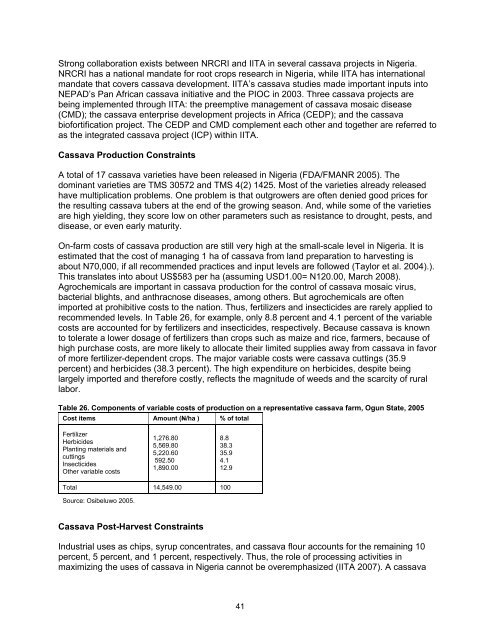Constraints to Increasing Agricultural Productivity in Nigeria: A Review
Constraints to Increasing Agricultural Productivity in Nigeria: A Review
Constraints to Increasing Agricultural Productivity in Nigeria: A Review
Create successful ePaper yourself
Turn your PDF publications into a flip-book with our unique Google optimized e-Paper software.
Strong collaboration exists between NRCRI and IITA <strong>in</strong> several cassava projects <strong>in</strong> <strong>Nigeria</strong>.<br />
NRCRI has a national mandate for root crops research <strong>in</strong> <strong>Nigeria</strong>, while IITA has <strong>in</strong>ternational<br />
mandate that covers cassava development. IITA’s cassava studies made important <strong>in</strong>puts <strong>in</strong><strong>to</strong><br />
NEPAD’s Pan African cassava <strong>in</strong>itiative and the PIOC <strong>in</strong> 2003. Three cassava projects are<br />
be<strong>in</strong>g implemented through IITA: the preemptive management of cassava mosaic disease<br />
(CMD); the cassava enterprise development projects <strong>in</strong> Africa (CEDP); and the cassava<br />
biofortification project. The CEDP and CMD complement each other and <strong>to</strong>gether are referred <strong>to</strong><br />
as the <strong>in</strong>tegrated cassava project (ICP) with<strong>in</strong> IITA.<br />
Cassava Production <strong>Constra<strong>in</strong>ts</strong><br />
A <strong>to</strong>tal of 17 cassava varieties have been released <strong>in</strong> <strong>Nigeria</strong> (FDA/FMANR 2005). The<br />
dom<strong>in</strong>ant varieties are TMS 30572 and TMS 4(2) 1425. Most of the varieties already released<br />
have multiplication problems. One problem is that outgrowers are often denied good prices for<br />
the result<strong>in</strong>g cassava tubers at the end of the grow<strong>in</strong>g season. And, while some of the varieties<br />
are high yield<strong>in</strong>g, they score low on other parameters such as resistance <strong>to</strong> drought, pests, and<br />
disease, or even early maturity.<br />
On-farm costs of cassava production are still very high at the small-scale level <strong>in</strong> <strong>Nigeria</strong>. It is<br />
estimated that the cost of manag<strong>in</strong>g 1 ha of cassava from land preparation <strong>to</strong> harvest<strong>in</strong>g is<br />
about N70,000, if all recommended practices and <strong>in</strong>put levels are followed (Taylor et al. 2004).).<br />
This translates <strong>in</strong><strong>to</strong> about US$583 per ha (assum<strong>in</strong>g USD1.00= N120.00, March 2008).<br />
Agrochemicals are important <strong>in</strong> cassava production for the control of cassava mosaic virus,<br />
bacterial blights, and anthracnose diseases, among others. But agrochemicals are often<br />
imported at prohibitive costs <strong>to</strong> the nation. Thus, fertilizers and <strong>in</strong>secticides are rarely applied <strong>to</strong><br />
recommended levels. In Table 26, for example, only 8.8 percent and 4.1 percent of the variable<br />
costs are accounted for by fertilizers and <strong>in</strong>secticides, respectively. Because cassava is known<br />
<strong>to</strong> <strong>to</strong>lerate a lower dosage of fertilizers than crops such as maize and rice, farmers, because of<br />
high purchase costs, are more likely <strong>to</strong> allocate their limited supplies away from cassava <strong>in</strong> favor<br />
of more fertilizer-dependent crops. The major variable costs were cassava cutt<strong>in</strong>gs (35.9<br />
percent) and herbicides (38.3 percent). The high expenditure on herbicides, despite be<strong>in</strong>g<br />
largely imported and therefore costly, reflects the magnitude of weeds and the scarcity of rural<br />
labor.<br />
Table 26. Components of variable costs of production on a representative cassava farm, Ogun State, 2005<br />
Cost items Amount (N/ha ) % of <strong>to</strong>tal<br />
Fertilizer<br />
Herbicides<br />
Plant<strong>in</strong>g materials and<br />
cutt<strong>in</strong>gs<br />
Insecticides<br />
Other variable costs<br />
1,276.80<br />
5,569.80<br />
5,220.60<br />
592.50<br />
1,890.00<br />
Cassava Post-Harvest <strong>Constra<strong>in</strong>ts</strong><br />
8.8<br />
38.3<br />
35.9<br />
4.1<br />
12.9<br />
Total 14,549.00 100<br />
Source: Osibeluwo 2005.<br />
Industrial uses as chips, syrup concentrates, and cassava flour accounts for the rema<strong>in</strong><strong>in</strong>g 10<br />
percent, 5 percent, and 1 percent, respectively. Thus, the role of process<strong>in</strong>g activities <strong>in</strong><br />
maximiz<strong>in</strong>g the uses of cassava <strong>in</strong> <strong>Nigeria</strong> cannot be overemphasized (IITA 2007). A cassava<br />
41
















